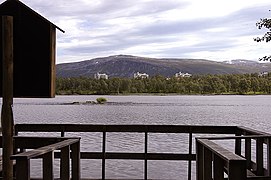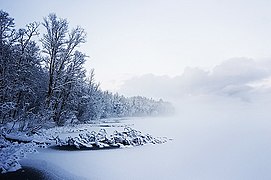Prestvannet
| Prestvannet | ||
|---|---|---|

|
||
| Geographical location | Tromsøya | |
| Islands | Peat islands | |
| Places on the shore | Tromso | |
| Data | ||
| Coordinates | 69 ° 39 '34 " N , 18 ° 56' 5" E | |
|
|
||
| Altitude above sea level | 96 moh. | |
| surface | 7.88 ha | |
| Middle deep | 2-4 m | |
|
particularities |
Landscape protection area |
|
The lake Prestvannet , rarely Prestvatn called a roughly eight-hectare artificial lake which is the Norwegian island of Tromsøya in the province ( Fylke ) Troms og Finnmark . Since 1970 the Prestvannet and its immediate surroundings have been a protected landscape area that also serves to protect animals .
geography
General
The Prestvannet lies entirely within the city of Tromsø . It is located in the southern part of the island of Tromsøya at 96 meters above sea level ( moh. ). The lake is shallow and usually no deeper than four meters. Greater depths are only reached in the center. The entire nature reserve has a size of around 18 hectares. The lake itself is 7.88 hectares and turns into a large swamp area in the south . There are other small swamp areas in the northwest, northeast and the eastern bank. A birch forest joins the wetland.
Emergence
As part of the drinking water supply for the city of Tromsø, the lake was dammed in 1867 over a moorland with small ponds . However, it was only used temporarily as a drinking water reservoir, as the water quality turned out to be too poor. With the construction of the new waterworks in Slettaelva in 1921, its use ceased.
Islands
There are peat islands in the lake , which were probably washed up by the rapid flooding of the moorland. In 1870 many peat islands were counted and Sparre Schneider also reported in 1889 a number of floating islands made of peat. Furthermore, parts of the peat edge can come off. They become floating islands, only to grow back together with the bottom later. The number varies from year to year. Bacteria in the lake break down organic matter. This creates gases that cause the peat islands to lift. This depends on the water temperature.
Bog birches on the north bank
ecology
Water quality
The water is rich in nutrients, with a large proportion of humus . This determines the color of the water, which is not very translucent. In a water test in August 2005, the phosphorus content was very high.
flora
There are basically two different types of plants that grow in Prestvannet: aquatic plants and marsh plants . The birch forest belongs to the genus of the bog birch .
Aquatic plants
There are only three different species of aquatic plants in the lake. They are among the most common in Norway. Most numerous is potamogeton berchtoldii (Potamogeton berchtoldii) , which settles at depths of one to one and a half meters. It occurs in both nutrient-rich and nutrient-poor waters. It also tolerates the poor light conditions in the lake and grows well on the flooded peatland. The pine frond (Hippuris vulgaris) is native to the north and east of the lake . It can also be found on dried-up mud banks. In the lower parts of the lake you can occasionally find floating pondweed (Potamogeton natans) .
Marsh plants
Sedges ( Carex aquatilis and Carex rostrata ) grow around the lake and can even be found on the peat islands. Many of the marsh plants grow up to two meters deep here. The pond horsetail (Equisetum fluviatile) grows in the northeast of the lake and forms many swimming islands that look like mainland. Other swamp plants that grow around the lake are swamp blood-eye (Potentilla palustris) and fever clover (Menyanthes trifoliata) .
fauna
Birds
Many birds find sheltered breeding grounds on the lake through the peat islands. The most frequently represented orders are the geese , plover-like and passerine birds . The following table shows a selection of the species represented. Some of the species are observed every year and others are sporadic. The order of the birds of prey is one of the rare visitors to the lake. In addition, gray herons and city pigeons can be seen at the lake. A specialty is the breeding place of the red-throated divers , as the birds are usually very shy and avoid being close to humans. Tromsø is one of the few places where the bird breeds near humans. Due to the diversity of species, animal protection in the landscape protection area is of great interest.
fishes
Due to the low oxygen content , only two different fish species could be established. The three-spined stickleback does not need a lot of oxygen, but due to the climate it can happen that the lake freezes completely. As a result, part of the population dies every winter. The crucian carp, which was also released in the lake, can switch from aerobic to anaerobic metabolism when there is a lack of oxygen. An anaerobic metabolic situation produces lactic acid, which is fermented to ethanol ( lactic acid fermentation ). Due to its lower freezing point, this alcohol acts as an “anti-freeze” in the blood, so that the crucian carp can survive the complete freezing of the lake. Excess alcohol can be excreted through the gills.
Leisure and Tourism
Today the lake is a recreational area for the city of Tromsø. Footbridges, bridges and benches have been installed from which you can watch the birds. Information boards educate the visitor. The adjacent forest area is a popular hiking area in Tromsø.
Individual evidence
- ↑ Prestvannet i Troms ( Memento of the original from March 4, 2016 in the Internet Archive ) Info: The archive link was inserted automatically and has not yet been checked. Please check the original and archive link according to the instructions and then remove this notice. (PDF; 292 kB) from the Norsk institutt for vannforskning. P. 6 - accessed on May 13, 2013 (Norwegian)
- ↑ Sterntaucher on the Prestvannet ( Memento of the original from March 16, 2014 in the Internet Archive ) Info: The archive link was inserted automatically and has not yet been checked. Please check the original and archive link according to the instructions and then remove this notice. . University of Tromsø - accessed on May 14, 2013 (German)
- ↑ Bird species on Prestvannet - accessed on May 14, 2013 (Norwegian) in the species database
Web links
- faktaark.naturbase from the Directorate for Naturforvaltning - accessed on May 13, 2013 (Norwegian)
- Prestvannet i Troms (PDF; 292 kB) from the Norsk institutt for vannforskning - accessed on May 13, 2013 (Norwegian)
- Birdwatching at Prestvannet from Tromsø University - accessed on May 13, 2013 (Norwegian)
- Alcoholics i Prestvannet on NRK - accessed May 13, 2013 (Norwegian)



